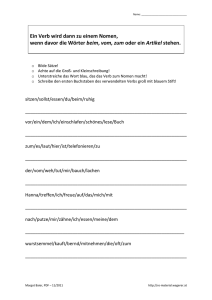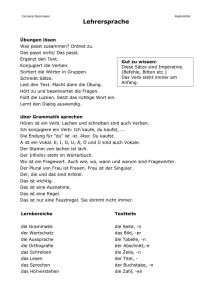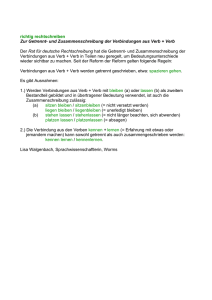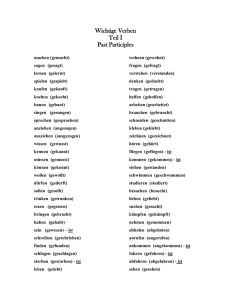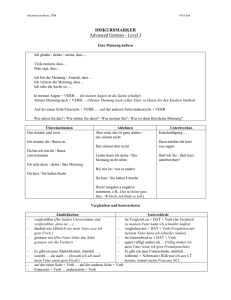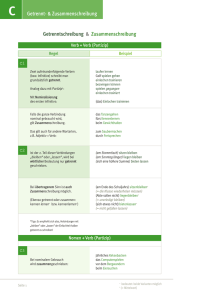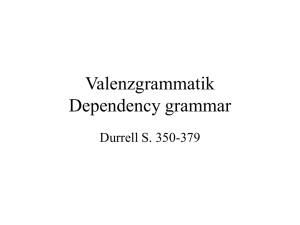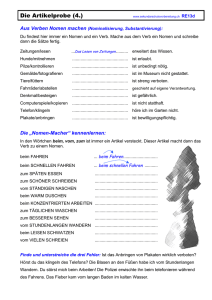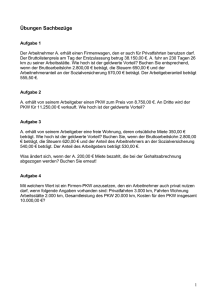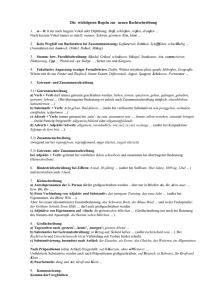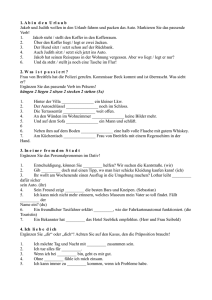1 Modal Verb to Auxiliary and back: Going by Implication F. Plank
Werbung
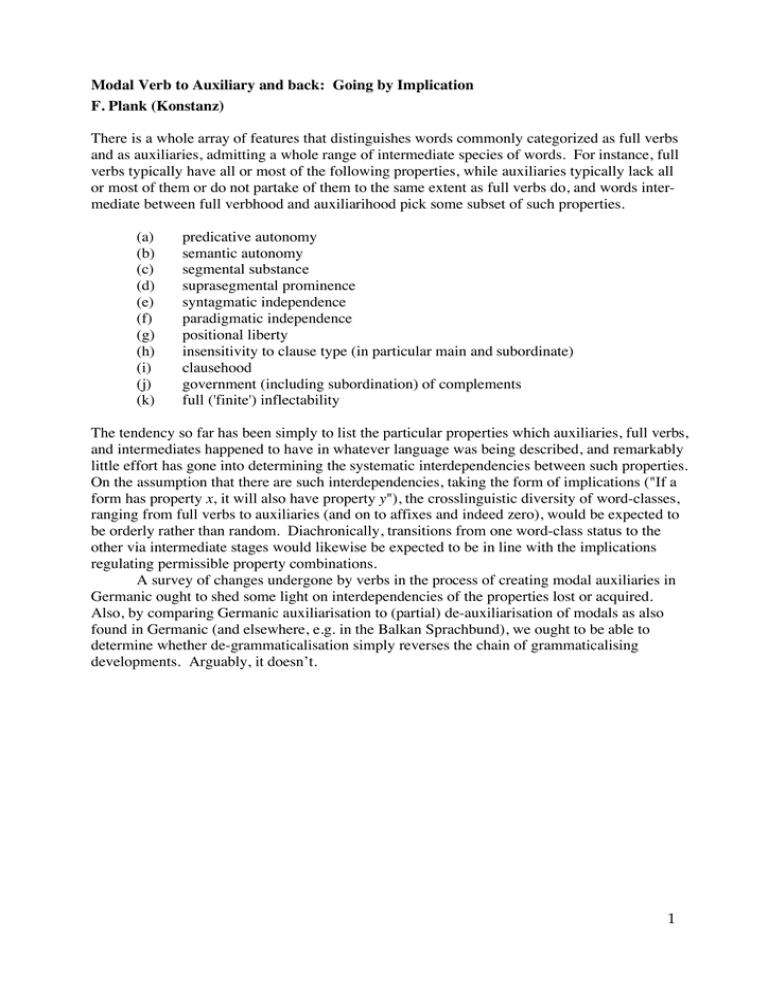
Modal Verb to Auxiliary and back: Going by Implication
F. Plank (Konstanz)
There is a whole array of features that distinguishes words commonly categorized as full verbs
and as auxiliaries, admitting a whole range of intermediate species of words. For instance, full
verbs typically have all or most of the following properties, while auxiliaries typically lack all
or most of them or do not partake of them to the same extent as full verbs do, and words intermediate between full verbhood and auxiliarihood pick some subset of such properties.
(a)
(b)
(c)
(d)
(e)
(f)
(g)
(h)
(i)
(j)
(k)
predicative autonomy
semantic autonomy
segmental substance
suprasegmental prominence
syntagmatic independence
paradigmatic independence
positional liberty
insensitivity to clause type (in particular main and subordinate)
clausehood
government (including subordination) of complements
full ('finite') inflectability
The tendency so far has been simply to list the particular properties which auxiliaries, full verbs,
and intermediates happened to have in whatever language was being described, and remarkably
little effort has gone into determining the systematic interdependencies between such properties.
On the assumption that there are such interdependencies, taking the form of implications ("If a
form has property x, it will also have property y"), the crosslinguistic diversity of word-classes,
ranging from full verbs to auxiliaries (and on to affixes and indeed zero), would be expected to
be orderly rather than random. Diachronically, transitions from one word-class status to the
other via intermediate stages would likewise be expected to be in line with the implications
regulating permissible property combinations.
A survey of changes undergone by verbs in the process of creating modal auxiliaries in
Germanic ought to shed some light on interdependencies of the properties lost or acquired.
Also, by comparing Germanic auxiliarisation to (partial) de-auxiliarisation of modals as also
found in Germanic (and elsewhere, e.g. in the Balkan Sprachbund), we ought to be able to
determine whether de-grammaticalisation simply reverses the chain of grammaticalising
developments. Arguably, it doesn’t.
1
Tabelle 1
Eigenschaften
Zweitbeste aller möglichen Welten: Geordnete Vielfalt
Formen
a
b
c
d
e
f
g
1
2
3
4
5
6
7
+
+
+
+
+
+
+
+
+
+
+
+
+
–
+
+
+
+
+
–
–
+
+
+
+
–
–
–
+
+
+
–
–
–
–
+
–
–
–
–
–
–
–
–
–
–
–
–
–
Regel für Eigenschaftskombinationen:
Für jede Form, wenn sie den Wert + für Eigenschaft n hat, hat sie auch den
Wert + für Eigenschaft n-1, und wenn sie den Wert – für Eigenschaft n hat,
hat sie auch den Wert – für Eigenschaft n+1.
Bei einer Ausgangslage wie in Tabelle 1 schematisch dargestellt ergeben sich
folgende Szenarien für den Wandel der Eigenschaften von Formen.
(Tabelle 1 >) Tabelle 2
Eigenschaften
Bewahrte Ordnung
Formen
a
b
c
d
e
f
g
1
2
3
4
5
6
7
+
+
+
+
+
+
+
+
+
+
+
+
–
–
+
+
+
+
–
–
–
+
+
+
–
–
–
–
+
+!
–
–
–
–
–
–
–
–
–
–
–
–
(Tabelle 1 >) Tabelle 3
Eigenschaften
Gestörte (und nicht wieder hergestellte) Ordnung
Formen
a
b
c
d
e
f
g
1
2
3
4
5
6
7
+
+
+
+
+
+
+
+
+
+
+
+
–!
–
+
+
–!
+
+
+
–
+
+
+
+
+
–
–
+
+
+
+
–
–
–
+
+
+
–
–
–
–
+
–
–
–
–
–
–
–
–
–
–
–
–
–
2
(Tabelle 3 >) Tabelle 4 (> ... > Tabelle 6)
Ordnungsgemäße Wiederherstellung
der Ordnung, I
Eigenschaften
Formen
a
b
c
d
e
f
g
1
2
3
4
5
6
7
+
+
+
+
+
+
+
+
+
+
+
+
–
–
+
+
+
+
–
–
–
+
+
+
–
–
–
–
+
–
–
–
–
–
–
–
–
–
–
–
–
–
+
+
–!
–!
+
+
–
(Tabelle 3 >) Tabelle 5 (> ... > Tabelle 6)
Eigenschaften
1
2
3
4
5
6
7
Ungeordnete Wiederherstellung
der Ordnung, I
Formen
a
b
c
d
e
f
g
+
+
+
+
+
+
+
+
+
+
+
+
–
–
+
+
+
+
–
–
–
+
+
+
–
–
–
–
+
–
–
–
–
–
–
–
–
–
–
–
–
–
+
+
–!
+
–!
+
–
(Tabelle 4/5 >) Tabelle 6
Eigenschaften
Formen
a
b
c
d
e
f
g
1
2
3
4
5
6
7
+
+
+
+
+
–
–
+
+
+
+
–
–
–
+
+
+
–
–
–
–
+
–
–
–
–
–
–
–
–
–
–
–
–
–
+
+
+
+
+
+
+
+
+
–!
–!
–!
–!
–
Wiederhergestellte Ordnung, I
Tabelle 6' (=Tabelle 6, Spalten vertauscht)
Eigenschaften
1
2
3
4
5
6
7
Wiederhergestellte Ordnung, I:
"Resozialisierung in neuer Umgebung"
Formen
a
c
d
e
b
f
g
+
+
+
+
+
+
+
+
+
+
+
–
–
–
+
+
+
–
–
–
–
+
+
–!
–!
–!
–!
–
+
–
–
–
–
–
–
–
–
–
–
–
–
–
+
+
+
+
+
–
–
3
(Tabelle 3 > ... >) Tabelle 7
Eigenschaften
Formen
a
b
c
d
e
f
g
1
2
3
4
5
6
7
+
+
–!
+
+
–
–
+
+
–!
+
–
–
–
+
+
–!
–
–
–
–
+
–
–
–
–
–
–
–
–
–
–
–
–
–
+
+
+
+
+
+
+
+
+
–!
+
+
+
–
Wiederhergestellte Ordnung, II
Tabelle 7' (=Tabelle 7, Zeilen vertauscht)
Wiederhergestellte Ordnung, II:
"Schlechtes Beispiel"
Eigenschaften
Formen
a
b
c
d
e
f
g
1
2
4
5
6
7
3
+
+
+
+
+
+
+
+
+
+
+
–
–
–!
+
+
+
–
–
–
–!
+
+
–
–
–
–
–!
+
–
–
–
–
–
–
–
–
–
–
–
–
–
+
+
+
+
+
–
–!
Die anhand einzelner Fallstudien entwickelte Hypothese ist, daß Grammatisierung in
einem Formenwandel nach dem Szenario der Bewahrten Ordnung (Tabelle 1 > 2)
besteht, wonach Eigenschaften sich stets nur so verändern, daß sie im Einklang mit den
implikationellen Regeln der Eigenschaftskombinationen bleiben. Bei Degrammatisierungen dagegen (einem Typ davon jedenfalls) scheint als erste Phase ein Zustand
der Gestörten Ordnung einzutreten (Tabelle 1 > 3), wonach Ordnung nach den Szenarien
der Resozialisierung (also des weiteren Formenwandels, Tabelle 3 > 4 > 6/6') oder des
Schlechten Beispiels (was auf einen Grammatikwandel hinausläuft, nämlich auf veränderte Regeln der Eigenschaftskombination, Tabelle 3 > 7/7') wiederhergestellt wird.
4
Adnominale Relationsmarkierungen zwischen Adposition und Kasus
_________________________________________________________________
Funktionswort (Adposition)---> <---(Kasus) Flexiv
Eigenschaften
a
b
Formen
c
d
e
♦
f
g
♦
_________________________________________________________________
1
+
+
+
+
+
+
+
2
+
+
+
+?
+
+
–
3
+
+?
+
+
+
+?
–?
4
+
+
+
+
+
–?
–
5
+
+
+
+
+?
–
–
6
+
+
+
+?
–?
–
–
7
+
+
+?
+
–
–
–
8
+
+?
+
+
–
–
–
9
+
+
+?
+?
–
–
–
10
+
+
+?
+?
–
–
–
11
+
+
+?
+
–
–
–
12
+
+
+
+?
–
–
–
13
–?
+
–?
+?
+?
–?
–
14
+
–?
+?
+?
–
–
–
15
+
+
+?
+?
–
–
–
16
+
–?
+?
–?
–?
–?
–?
17
+?
+
–
–
–
–
–
18
+
–
–
–
–
–
–
19
+
–
–
–
–
–
–
_________________________________________________________________
Formen:
a
b
c
d
Präposition of im Englischen
Genitiv im Türkischen
Genitiv im Dänischen
Genitiv im Englischen [degrammatisiert aus dem altengl.
e
f
g
Genitiv im Deutschen
Genitiv im Altenglischen
Genitiv im Lateinischen
Genitiv]
5
Eigenschaften von Relationsmarkierungen (RM):
1.
2.
3.
4.
5.
6.
7.
8.
9.
10.
11.
12.
13.
14.
15.
16.
17.
18.
Die Kombination aus RM und ihrem Träger erfolgt stets semantisch vollkommen regelmäßig (+) oder sie tut das nicht (d.h. es gibt manchmal semantische Idiosynkrasien) (–).
Die RM verbindet sich produktiv mit allen Mitgliedern der jeweiligen Träger-Klassen (+)
oder sie tut das nicht (d.h. sie wird von einzelnen an sich möglichen Trägern ohne phonologische oder morphosyntaktische Gemeinsamkeit zurückgewiesen) (–).
Die Kombination aus RM und ihrem Träger erfolgt stets phonologisch vollkommen
regelmäßig (+) oder sie tut das nicht (d.h. es gibt manchmal phonologische Idiosynkrasien) (–).
Die Form des Trägers der RM ist unabhängig von der morphologischen Kategorie der
RM (+) oder sie ist das nicht (d.h. es gibt durch die RM morphologisch bedingte
Alternanten) (–).
Die RM braucht bei nicht-koordinativen Nominalen, die mehr als ein Substantiv
enthalten, und insbesondere bei komplexen Eigennamen, die aus Vor- und
Familiennamen, Titel (u.ä.) und Namen, Vornamen und Präposition und Geschlechtsbzw. Landesnamen bestehen, nur einmal zu stehen (+) oder sie muß mehrfach (d.h. bei
jedem einzelnen Substantiv) stehen (–).
Die RM braucht bei koordinierten Nominalen nur einmal zu stehen (+) oder sie muß
mehrfach (d.h. bei jedem einzelnen Nominale) stehen (–).
Die RM (bzw. die Kategorie, die sie ausdrückt) entzieht sich der Verteilung auf
verschiedene Bestandteile einfacher Nominale mittels Kongruenz (+) oder sie tut das
nicht (d.h. Adjektive, Artikel u. dgl. kongruieren mit dem Substantiv im Hinblick auf die
RM) (–).
Die RM ist frei, sich mit Trägern verschiedener Wortarten zu verbinden (falls sie sich
prosodisch bindet) (+) oder sie ist das nicht (d.h. sie bindet sich prosodisch nur an
bestimmte Wortarten, namentlich Substantive) (–).
Die RM zusammen mit ihrem Träger braucht nicht unbedingt als Einheit für alle syntaktischen Zwecke dienen (+) oder sie muß das (–).
Manche Nominale in manchen grammatischen Relationen können einer ausdrücklichen
RM dieser Art ermangeln (+) oder sie können das nicht (d.h. derartige RM’s sind für alle
Nominale in allen Relationen zwingend) (–).
Die RM ist obligatorisch am Rand ihres Nominales plaziert (+) oder sie ist das nicht (und
kann folglich im Inneren ihres Nominales stehen) (–).
Die RM ist rein relationaler, nicht-kumulativer Art (+) oder sie ist das nicht (d.h. sie
drückt kumulativ weitere Kategorien mit aus) (–).
Die RM hat eine relativ konkrete, spezifische Bedeutung (+) oder nicht (d.h. ihre Bedeutung ist eher abstrakt, allgemein) (–).
Die RM verändert den syntaktischen Charakter ihres Nominales (+) oder verändert ihn
nicht (d.h. das Nominale wird eine Adpositional- oder bleibt eine Nominalphrase) (–).
Die RM ist in ihrer Form unabhängig von morphologischen oder morphosyntaktischen
Eigenschaften ihres Trägers (+) oder sie ist das nicht (d.h. sie weist von solchen Eigenschaften bedingte Form-Varianten auf) (–).
Die RM ist in ihrer Form, abgesehen von allgemeinen phonologischen Alternationen, unabhängig von phonologischen Eigenschaften ihres Trägers (+) oder sie ist das nicht (d.h.
sie weist von solchen Eigenschaften bedingte Form-Varianten auf) (–).
Die RM kann innerhalb einer einfachen Phrase mit einer RM der gleichen formalen Art
kombiniert werden (+) oder sie kann das nicht (–).
Die RM ist Mitglied einer relativ großen, offenen, nicht besonders gut strukturierten
paradigmatischen Klasse von Formen (+) oder sie gehört keiner derartigen Klasse an
(sondern einer relativ kleinen, geschlossenen, wohl-strukturierten) (–).
6
19. Die RM kann direkt mit einer anderen RM der gleichen formalen Art koordiniert werden
(+) oder sie kann das nicht (–).
7
Formtypen von Modalitätsausdruck
A. Unterordnender Hauptsatz: (Es ist) möglich/notwendig/evident dass p; Ich vermute, dass p;
(Es) scheint, dass p
B. Nachgestellter u. Hauptsatz: Die Bedienung hat mein Bier vergessen, bilde ich mir ein/scheint mir
C. Parenthese:
Die Bedienung hat, scheint mir, dein Bier vergessen
D. Amalgamierung:
Ich habe das vor Gott weiss/du kannst dir gar nicht vorstellen
wie vielen Jahren schon einmal erzählt
E. Nebensatzverhauptsatzung: Mir scheint, mein Bier vergessen hat die Bedienung
F. Insubordination (mit Comp): Dass/Ob sie es vergessen hat!?
G. Hauptsatz mit infinitem Nebensatz:
Ich rate dir, zu verschwinden
H. Clause Union:
Die Bedienung scheint mir dein Bier vergessen zu haben
I. Adverb:
J.
K.
L.
M.
N.
O.
P.
Q.
Die Bedienung hat scheints/möglicherweise dein Bier vergessen;
Deine Erklärung ist weiss Gott nicht überzeugend;
Hertha ist Tatsache in der Champions’ League weitergekommen
Partikel (oft klitisch):
Die Bedienung hat wohl/fei/ja dein Bier vergessen
Fake Coordination
Komm (und) hau ab!
Serialisierung, Complex Predicate
Auxiliar:
Die Bedienung mag/muss dein Bier vergessen haben
Verbflexion:
Behuet-e dich Gott
Derivation:
Das Bier ist ungenießbar; Der Scheck ist zahlbar zum nächsten Ersten
Satztypen entsprechend Sprechakttypen
Zero:
zB Ausdruck von Nicht-Assertion bzw auch Neg im Süddravidischen
This car seats 8 adults
Historische Quellen von Modalitätsausdrücken (inkl. Evidentialität, Quotativität ...):
(i)
(ii)
(iii)
(iv)
Nomina, Verben, Adjektive in unterordnenden Hauptsätzen: via Grammatisierung
(Integration, Entunterordnung mittels Mod-Lowering oder p-Raising)
Ausdrücke für andere Kategorien: via Reanalyse
Mitnutzung von Ausdrücken für andere Kategorien (zB Tempus, Person)
Entlehnung
8
9
Between Verb and Auxiliary: Present-Day Modern English
___________________________________________________________________________
LEXEME (VERB)----->
<-----(AUXILIARY) GRAMMEME
desire
plan
see
go
let
do
∅
need
♦
dare
ought
may
can
must
___________________________________________________________________________
10
3
5
2
14
17
☞11
☞13
9
☞15
4
6
1
7
8
16
12
+
+
+
+
+
+
+
+
+
+
+
+
+
+
+
+
+
+
+
+
+
+
+
+
+
+
+
+
+
+
+
+
+
-
+
+
+
+
+
+
+
+
+
+
+
+
+
+
+
+
-
+
+
+?
+
+
+
+
+
+
+
+
+?
+
+
+ -?
-
+
+
+?
+
+
+
+
+
+
+
+
+
+
+?
+
-
++
+++++
- +++
+++++++++-
++
+
+?
+
+?
+0
+++++?
+
+
-?
-?
+-
++
+
+?
+
+?
+?
++++-?
+-?
+-
+
+
+
+
0
+?
-?
-
+
+
+
+
0
0
+
+
+
+
0
+
+
+
0
0
___________________________________________________________________________
desire
plan
see
go
let
do
need
dare
ought
may
can
must
LEXEME (VERB)----->
<-----(AUXILIARY) GRAMMEME
___________________________________________________________________________
10
Properties of words in the domain verb<--->auxiliary
1
2
3
4
5
6
7
8
9
10
☞11
12
☞13
14
☞15
16
17
needs no further (overt or elliptic) verb to form a complete predication (intransitive or
transitive)
has the segmental substance of typical lexical items (verbs, nouns, adjectives) and lacks
corresponding segmentally reduced 'short' forms
is capable of bearing (non-contrastive stress), and normally indeed does
combines freely with grammatical markers of tense, aspect, negation, agreement/crossreference, voice, causativity, speech-act, without entering close syntagmatic association
with them (fusion, mutual exclusion or requirement)
is not a member of a relatively small, semantically well-organised, and high-frequency set
of words with otherwise similar properties; i.e. may be a member of a lexical field but not
of a genuine paradigm
has positional autonomy and is at any rate positionally not so limited as always to be
ordered relative to some (segmentally more substantial and suprasegmentally more
prominent) pivot
occurs indiscriminately in all clause types, main and subordinate, finite and non-finite,
declarative, interrogative and other
establishes a clause
has an argument frame of its own, and may in particular govern a direct object (nominal or
finite clause) or an adverbial, and is bound up with relational interchanges (as in
passivization)
favours a personal rather than impersonal construction of its clause, if there is such a
contrast
when combining with a predicating word, subordinates it or is coordinate with it
when subordinating a predicating word, admits no weakening of the marking of
subordination ([tu(:)] —> *[tß], perhaps accompanied by stronger fusion of word and
marker, as in [ju:stß] instead of [ju:zd tu], gonna, hafta, etc.)
inflects for all person-numbers, provided this is an inflectional category of the language
concerned
inflects for all tenses, provided this is an inflectional category of the language concerned
inflects for all non-finite categories (infinitive, participles, gerund), provided there is a
contrast of finite and non-finite
inflects for voice, provided this is an inflectional category of the language concerned
its inflection shows no formal idiosyncrasies
11
Between verb and auxiliary: Early Modern English, before 16th century
___________________________________________________________________________
LEXEME (VERB)----->
<-----(AUXILIARY) GRAMMEME
desire
see
go
plan
need
∅
let
do
♦
♦
dare
♦
can
ought
♦
may
must
___________________________________________________________________________
14
12
15
5
13
11
4
9
+
+
+
+
+
+
+
+
+
+
+
+
+
++
+
+
+
+
+
+
++
+
+
+
+
+
+
+
+
+
+?
+
+
+
+
-?
+
+
0
+
+
+
+
-
+
0
+
+
+
+
+?
+?
+
-?
-
+?
0
- +
-?
+
-
0
-
0
-?
___________________________________________________________________________
desire
see
go
plan
need
let
do
dare
can
ought
may
must
LEXEME (VERB)----->
<-----(AUXILIARY) GRAMMEME
___________________________________________________________________________
properties:
14
12
15
5
☞13
☞11
☞4
9
regularly contrasts past to present tense
prohibits weakening of [tu] to [tß] and perhaps further integration/contraction
has no non-finite inflections
is an ordinary strong or weak verb rather than belonging to the preterite-presents
takes 3Sg -s
requires to rather than bare infinitive
prohibits contraction of not to n’t
governs an object or adverbial
cf. also con/cun (with 3Sg -s) differentiated from can
doeth [duÜIT] vs. doth [døT]
(16c)
(19c)
12
dare
I.
OE preterite-present durran
3Sg -Ø:
he dear(r)
(2Sg -st: dearst)
Inf without to:
Gif he Jesecean dear (Beow.)
Who dare tell her so? (1599)
Nor dare she trust a larger lay (1850)
II.
since early 16c
alternatively 3Sg -s
(and past tense dared, instead of old dorste/durst; but plain dare also used in pasttense function:
But she went into no trance; she dare not (1857))
(also, transitive use, with nominal direct object, since 16c; here always
regular verb inflection, viz. dares, dared:
What wisedome is this in you to dare your betters? (1589)
I dare him therefore To lay his gay Comparisons a-part (1606))
Inf without to:
The kokold ... for hys lyfe daryth not loke hether ward (1533)
Who dares do more (1605)
The fearful Stag dares for his Hind engage (1697)
No priest dares hint at a Providence which ... (1856)
Inf also with to:
They sholde not have durst the peoples vyce to blame (1509)
They have dared to break out so audaciously (1529)
The Counsell ... neither durst to abridge or diminish any of them (c1555)
None now daring to take the same from you (1586?)
She darde to brooke Neptunus haughty pride (c1590)
If we dare to judge our Makers Will (1592)
They dared not to stay him (1650)
The man who dares to die (1798)
Any one who dared to lay hands on him (1883)
need
I.
OE weak verb neodian/neadian
3Sg neodaπ
Finite-clause complement or oblique objects ('to be necessary, to be need'),
or AcI with or without to, or direct object and adverbial ('to force, compel'):
Utlagan us wepan neadiaπ
Ne neadige hine man to fæstene
3Sg -eth/-s and Inf with (for) to:
More πan he nediπ for to have (c1380)
II.
since 16c
(when not used as an ordinary verb, as in:
He needs you
It needs heaven-sent moments for this skill)
3Sg also -Ø:
Inf with to:
This is as plaine as neede to be (1579)
How prejudicial such Proceedings are ... need not be defin’d (1728)
My stooping need not to have disturbed you
(1771)
Inf without to: (that thai neid nocht gang by (c1470))
13
he nede commaunde non other (1538)
3Sg -s continuing:
Inf with to:
Inf without to:
Vice ... needs but to be seen (1732)
A Man needs spend but a twentieth part less (1687)
14
